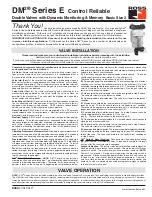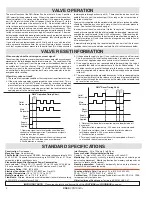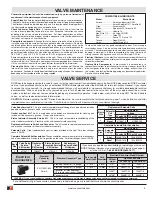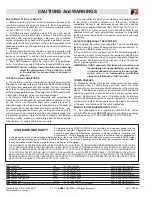
VALVE INSTALLATION
DM
2®
Series E
Control Reliable
Pneumatic equipment should be installed only by persons trained
and experienced in such installation.
Air Lines: Before installing this valve in a new or existing system, the air
lines must be blown clean of all contaminants. It is recommended that a
5-micron-rated air filter be installed in the inlet line close to the valve.
Valve Inlet (Port 1): Be sure that the supply line is of adequate size and
does not restrict the air supply because of a crimp in the line, a sharp bend,
or a clogged filter element. The air supply must not only provide sufficient
pressure (see Standard Specifications, page 2), but must also provide an
adequate flow of air on demand.
Valve Outlet (Port 2): For faster pressurizing and exhausting of the
mechanism being operated by the valve, locate the valve as close as
possible to the mechanism. The lines must be of adequate size and be
free of crimps and sharp bends.
Valve Exhaust (Port 3): Do not restrict the air flow from the exhaust port as
this can adversely affect the operation of the valve. The valves are factory
equipped with a properly sized silencer. ROSS silencers reduce impact
noise by as much as 25 dB, with minimum back pressure.
Reset Solenoid: DM
2®
Series E valves are supplied with a 3/2 normally
closed solenoid valve for reset purposes. Electrical reset signal must be
momentary and of correct voltage.
Electrical Supply: DM
2®
Series E valves get electrical power through plug-
in connectors. The electrical supply must correspond to the voltage and
frequency ratings of the solenoids; otherwise the solenoids are subject to
early failure. If power is supplied by a transformer, the power supply must
be capable of handling the maximum power. See Valve Specifications on
page 2 for information on maximum power.
Operating Pressures and Temperatures: Allowable ranges for pressure and
temperatures are given in the Standard Specifications on page 2. Exceeding
these values can adversely affect performance and shorten valve life.
Pipe Installation: To install pipe in ports, engage pipe one turn, apply pipe
thread sealant (tape not recommended), and tighten pipe. This procedure
will prevent sealant from entering and contaminating the valve. To install
pipe with parallel threads (e.g., SAE, ISO 228-I, etc.) do not use sealant.
Test: After installation or repair and prior to normal use, the valve must be
tested for proper functioning. Observe normal equipment operation safety
precautions such as lockout procedures during these tests to avoid personal
injury or damage to equipment.
DM
2®
Series E Test Procedure: NOTE: DM
2®
Series E valves include a
memory function, and once “locked-out”, must be reset by a dedicated reset
function in order to be operated further. Therefore, it may be necessary to
perform a reset on the valve prior to beginning the test procedure below.
In order to reset the valve, make sure that supply pressure is present and
both pilot solenoids are de-energized, then momentarily energize the reset
solenoid for at least 200 milliseconds.
A) Electrically energize both pilot solenoids simultaneously. The valve
should supply pressure from inlet port (1) to outlet port (2).
There should be no flow to the exhaust port (3) at this time.
B) De-energize one of the pilot solenoids. The valve should go into a lockout
condition such that any downstream pressure in the outlet port (2) will be
exhausted to atmosphere through exhaust port (3). There should also be a
small, but audible, flow of air out the exhaust port (3) as long as the valve
remains in the lockout condition.
C) Re-energize the pilot solenoid that was de-energized in step B above.
The valve must remain in the lockout condition.
D) De-energize both pilot solenoids. The valve must remain in the lockout
condition.
E) Momentarily energize the reset solenoid (at least 200 milliseconds) to
reset the valve. The valve should return to the "ready-to-run" condition.
There should be no pressure present at outlet port (2) and there should no
longer be any audible flow of air to exhaust port (3).
F) Energize both pilots simultaneously again. As in step A above, the valve
should supply pressure from inlet port (1) to outlet
port (2). There should be no flow to the exhaust port (3).
G) De-energize the other pilot solenoid. As in step B above, the valve should
again go into a lockout condition.
H) Re-energize the pilot solenoid that was de-energized in step G above.
The valve must remain in the lockout condition.
I) De-energize both pilot solenoids. The valve must remain in the lockout condition.
J) Momentarily energize the reset solenoid again (at least 200 milliseconds)
to reset the valve. The valve should return to the "ready-to-run" condition as
in step E above.
DM
2®
Series E Reset Function: Both pilots must be de-energized during
the reset function. A momentary delay is required to complete the reset
function after the reset solenoid is energized.
Lockout Indication: The built-in status indicator shall be used to signal the
machine controls that a lockout has occurred. The status indicator utilizes
a pressure switch. The pressure switch has 4 electrical contacts. (
NOTE:
Contact 4 is a ground.) During normal operation the pressure switch is
pressurized. A lockout condition depressurizes the switch until the valve
is "ready to run" after a reset function has been performed . Contacts 1
and 2 are closed when the switch is depressurized (normally closed) and
contacts 1 and 3 are closed when an adequate pressure signal is applied
to the switch (normally open).
Thank You!
You have purchased a premium-quality ROSS
®
pneumatic valve. It is a high quality DM
2®
Series E Control Reliable double valve with Dynamic Monitoring and Memory for Category 3 and 4 applications, except press
clutch/brake applications. With care in its installation and maintenance you can expect it to have a long and economical
service life. Before you install this valve, read the information in this folder completely, and save it for future reference.
IMPORTANT APPLICATION NOTE: Because of its air flow & exhausting characteristics, this valve is not for use
in press clutch/brake applications. ROSS produces the Series DM
2®
Series D
and a number of other double valve
configurations with flow & exhaust characteristics for press clutch/brake applications.
Double Valves with Dynamic Monitoring & Memory
Basic Size 2
ROSS
CONTROLS
®
www.rosscontrols.com
Please read and make sure you understand all installation instructions before proceeding with the installation.
Additional technical documentation is available for download at www.rosscontrols.com.
If you have any questions about installation or servicing your valve, please contact ROSS or your authorized ROSS distributor, see contact
information listed at the back of this document, or visit www.rosscontrols.com to find your distributor.
VALVE OPERATION
NOTE: DM
2®
Series E valves include a memory function, and once “locked-out”, must be reset by a dedicated reset function in order to operate further.
The DM
2®
Series E valve cannot be reset simply by removing electrical power from both pilot solenoids and/or turning off supply air pressure. Therefore,
it may be necessary to perform a reset on the valve prior to normal operation. In order to reset the valve, make sure that supply pressure is present and
both pilot solenoids are de-energized, and then momentarily energize the reset solenoid for at least 200 milliseconds.






















